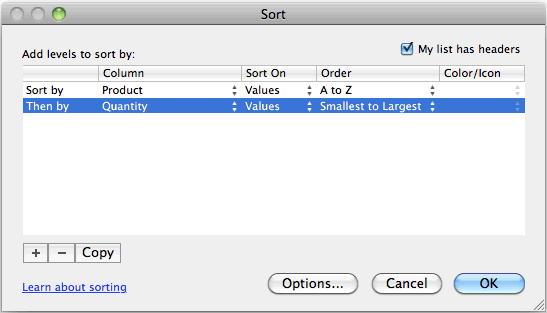
- SORT A COLUMN BY OCCURRENCE COUNT IN EXCEL 2016 FOR MAC CODE
- SORT A COLUMN BY OCCURRENCE COUNT IN EXCEL 2016 FOR MAC PROFESSIONAL
The INDEX(names,…) piece should be obvious, and is unavoidable anyway. Let’s consider the ‘megaformula’ in this problem (modified): You could even get tricksy and use SQL.REQUEST with the sort expressed as a SQL query which would arguably be the clearest way to do this. With the names in D1:D122, select E1:E122 and enter the array formula In this case, using Laurent Longre’s MOREFUNC.XLL add-in. If one of the basic goals is NOT reinventing the wheel, then udfs would arguably be best. And it doesn’t avoid complexity entirely: it’s still necessary to understand the flow of calculations through multiple cells. However, using several columns of intermediate calculations introduces greater chance for error just by spanning more cells. So if it were only a question of clarity, different people would make different choices. Most forms of multireferent indexing are unclear. Why go out of your way to provide an approach inferior to the average newsgroup responses of old? The column G results produce the desired sorted list.

If you don’t need to show the lengths in column E, change the column E formulas toĮ1: =LEN(D1)-(ROWS(E$1:E1)-1)/ROWS(D$1:D$122) How many times was this asked and ANSWERED BETTER in the newsgroups?! Bad policy to get lazy and use them even in simple examples just to avoid a little typing. Simple rule of thumb: ROW(), COLUMN() and CELL(“attribute”) without range reference arguments are almost always errors. With F1 filled down into F2:F122 would return the correct results no matter how many rows were inserted above. Would return undesired results if any rows were inserted above row 1, but ©¿©¬ Posted in Excel Intermediate, Formulas Post navigationįirst there’s the classic bug-in-waiting of using ROW() when ROWS(…) is much safer, e.g., For extra credit, and no peeking, what’s the shortest name? INDIRECT() is volatile, so there is a penalty for this. The names are now sorted by length, by alphabet. In Column I, I1 =INDEX(D:D,H1), filled down. We add the original 30 to that, and the index is now 63. We are looking for the relative location of the lookup_value (22) in a new lookup_range (E31:E122). This may be better seen in H3, adjacent to G3, where the first repeat starts. We add H1 to that result, and we have our index down Column D. It builds the range one row down (H1+1) from the first of a repeating match. The sliding range is made by the INDIRECT() function. If the value did not repeat, just copy it over and if it didn’t, we’re making a “sliding range” that starts one row after the start of a repeated pair, ends at the end of the data, and “slides” down Column E. So, using Col(H) now as a helper column, in H1 put =G1. If in H1 we put =INDEX(D:D,G1) and filldown, we get: You can begin to see the problem: There are three teams with a 22-letter name, three with a 21-letter name, and at least 3 (in fact 13) with a 20-letter name. You’ll see from the data that the longest name is 29 letters, and it’s in ROW(52).

SORT A COLUMN BY OCCURRENCE COUNT IN EXCEL 2016 FOR MAC CODE
In G1 put the code =MATCH(F1,$E$1:$E$122,0) and fill down. Then you want to know how far down Column E those descending numbers fall, so that you can Index the name list that amount. The ROW() function will cause the return of the first largest, then the second largest etc. In F1 you put =LARGE($E$1:$E$122,ROW()) and fill down. You can do it from the Sort selection, but we also want to keep the alpha-sort.

Your data might look like this:įor no good reason we want to create a descending sort on name length. In Column E you have code that returns the length of the team name, i.e.
SORT A COLUMN BY OCCURRENCE COUNT IN EXCEL 2016 FOR MAC PROFESSIONAL
However, if you have unique entries with the duplicated criterion, how do you return all the unique values?įor example, you have a list of the 122 major professional sports teams (32 NFL, and 30 MLB, NBA, and NHL) sorted alphabetically in Column D. For instance, if you have duplicate entries, returning the first match is no different than returning the last match. Excel’s MATCH() function will return the relative location of the first occurrence that satisfies the match criterion (the lookup_value) within the specified array (the lookup_array).


 0 kommentar(er)
0 kommentar(er)
